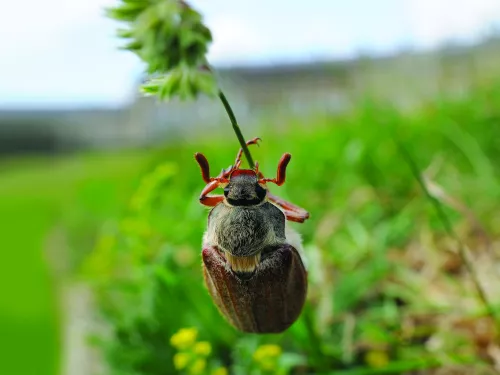Common clubtail
The Common clubtail is on the wing in spring and summer. It is an elusive dragonfly that is easiest to see when it first emerges. It can be found along rivers in Southern England and Wales.
The Common clubtail is on the wing in spring and summer. It is an elusive dragonfly that is easiest to see when it first emerges. It can be found along rivers in Southern England and Wales.

This large, brown beetle can be seen swarming around streetlights in spring. They live underground as larvae for years and emerge as adults often in large numbers. Listen for their characteristic buzzing sound.
The drooping, tubular, pink flowers of Common comfrey are a familiar sight to many gardeners. Sometimes considered a 'weed', this hairy plant can be used as an organic fertiliser and a form of slug control.
The fluffy, white heads of common cotton-grass dot our brown, boggy moors and heaths as if a giant bag of cotton wool balls has been thrown across the landscape!
Common couch is a tall, tuft-forming grass of roadside verges, waste ground and arable land. It is very tough and can shade out more delicate plants. Look for flat, blade-like leaves and thin flower spikes.
Common cow-wheat is a delicate annual that brightens up the edges of acid woodland and heaths with deep golden flowers in the summer.

As the UK’s tallest bird the common crane is instantly recognisable with the ruffle of tail feathers and very long legs. Their bugling call is also very distinctive.
As it names suggests, the common crossbill has a large bill that is crossed at the tip - perfect for picking the seeds out of pine cones. Look for it in conifer woodlands, mainly in the north and south.
Cuttlefish are related to squids and octopuses – a group of molluscs known as cephalopods. You may have seen the chalky internal shell, called a cuttlebone washed up on beaches around the UK. These are often used in budgie cages, as a calcium-rich dietary supplement for the bird.
He loves me, he loves me not' is a familiar rhyme associated with what is probably our most well-known plant: the common daisy. Its white-and-yellow flower heads brighten up lawns, verges and short turf almost everywhere.
The common dandelion is a most familiar flower: counting down the 'clock', while blowing the fluffy seeds from its head, is a favourite childhood game. Dandelions are an important early source of food for pollinators - so let them grow!
The Common darter is a red, narrow-bodied dragonfly that can be seen throughout summer and autumn. It is hovers around all kinds of waterbodies, darting out to surprise its prey.